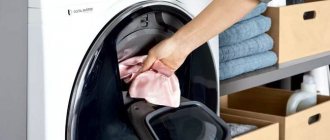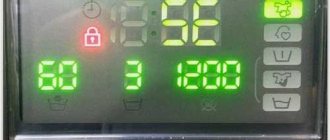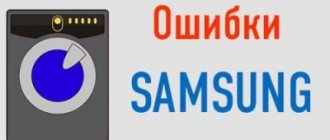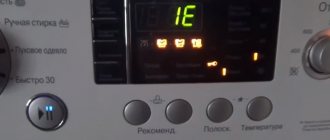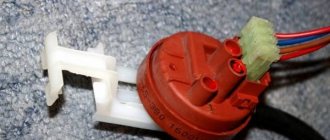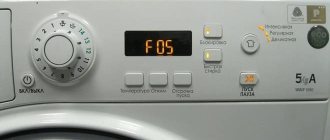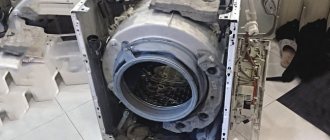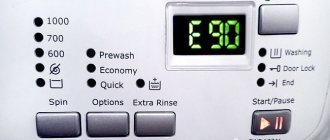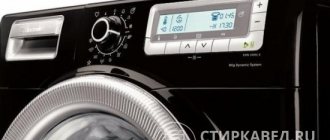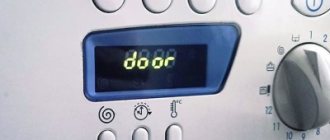The values of the error codes that appear on the display of Samsung washing machines - dE, door, DE1, DE2, DC, DC1, DC2, ED, DC3, DDC - indicate problems with the hatch or additional door. This is a fairly simple problem that you can solve on your own.
dE, door, DE1, DE2, DC, DC1, DC2, ED DC3 DDC
On models not equipped with a display, this error is indicated by the lighting of all mode and temperature selection indicators. This is shown in the photo.
Error display by indicators.
Causes of error - dE, door, DE1, DE2, DC, DC1, DC2, ED
Please note that the ED code appears on older models that are no longer in production. Let's look at the reasons why a breakdown occurs:
- The hatch is not completely closed.
- Contact connection error due to broken hook or entire mechanism.
- The lock is faulty.
- UBL contacts or wires are damaged.
- Incorrect connection.
- Control module failure.
- The error occurs if the lock was closed/opened more than 20 times in 2 minutes.
- The reason may also be strong impacts on the door during operation and powerful pressing of the door due to the difference in pressure in the “Boiling” program.
de error on Samsung.
The closing signal does not reach the electronic module, and as a result, this code appears and the operation of the machine is blocked.
Possible faults requiring repair
We figured out that the codes dE, Ed, dE1, dE2, dC, dC1, dC2, door are lit on the Samsung display if the hatch door is not closed, and we checked all the reasons not related to the breakdown. Now let's talk about the main malfunctions that cause these errors.
Faulty UBL (hatch blocking device) - from 1200 rubles*
A door lock or UBL is a locking mechanism that locks the hatch in the closed position while the washing machine is operating. The lock prevents the door from being opened from the outside for security reasons. If the mechanism is faulty, the control unit does not receive a signal that the door is locked and does not give the command to start washing.
The UBL mechanism fixes the hook in the lock. By type of action, blocking can be thermal or electronic. In a thermal UBL, most often, the thermal tablet is destroyed, which, when voltage is applied to it, heats up and bends the bimetallic plate. Occasionally the plate itself loses flexibility. In electronic UBLs, the electromagnet usually burns out.
Thermal mechanical UBLs are installed on old machines and inexpensive modern models. Electronic devices - on SMA with a higher price and in the luxury class.
From the experience of the masters! A broken hatch locking device is the most common cause of the dE error.
SIGNS
- when you turn on the machine, the door does not lock, the washing does not start, the dE error is on;
- at the end of the program: there is a message on the display, the door cannot be opened, the laundry cannot be taken out.
HOW TO FIX
The UBL cannot be repaired; the hatch lock needs to be replaced.
The control unit has failed - from 1800 rubles*
The control module controls the operation of the washing machine and is responsible for the interaction of the nodes. Possible malfunctions of the control board are:
- A resistor, capacitor or other element of the self-diagnosis system has burned out, or a track on this section of the board has burned out. Without self-diagnosis, the Samsung machine cannot check the status of the UBL and does not allow the program to start.
- A capacitor, resistor, other radio elements, connector or track on the section of the board associated with the UBL have burned out. For this reason, the unit cannot control the lock and the door does not lock.
- It is very rare that the control module processor fails.
SIGNS
The hatch is not blocked, the dE code lights up when starting the washing program.
HOW TO FIX
- You need to check the elements of the self-diagnosis system on the board.
- It is necessary to check the elements in the UBL circuit on the board: radio components, contacts, tracks.
After establishing the cause, it is necessary to replace the burnt radio elements, solder the tracks and contacts. If the processor burns out or most of the board burns out, then it is completely replaced.
Damaged door hinges - from RUB 1,100*
The error may appear due to problems with the door. For the UBL to work, the tongue or hook on the door must fit into the lock on the body of the machine. When the hatch is skewed, the locking element does not fit into the key hole. The shift is associated with the door hinges. On older washers, they wear out and sag over time. On new cars, the hinges become deformed from heavy loads, for example, children rolled on the door or something heavy fell on the open hatch.
SIGNS
The door does not close, does not lock, and it is externally noticeable that it is skewed relative to the hole in the body. The Samsung machine shows dE on the screen.
HOW TO FIX
You need to replace the damaged hinge or hinges (if your Samsung washing machine has two of them).
Mechanically damaged lock - from RUB 1,200*
The role of the lock in the SMA is performed by the hatch locking device. If it breaks, the door hook is level with the hole, but does not go inside. The plastic groove breaks very rarely; most often, the locking mechanism jams, which lowers and blocks the entrance to the hole.
SIGNS
The tongue does not fit into the hole, the lock does not close, and the door does not lock. Samsung shows error door, dE, Ed, dE1, dE2, dС, dC1 or dC2 at startup.
HOW TO FIX
The lock needs to be replaced, it cannot be repaired.
How to fix
Let's look at each point about what needs to be done to correct the situation:
- You just need to close the hatch tightly until you hear a characteristic click, and restart the program.
- Breakages of the back part of the lock—the hook or internal fasteners—occur. This occurs due to premature pulling of the hatch opening handle, which leads to the breakdown of one of the parts of the mechanism. You need to remove the door and disassemble it. Then install a new one in place of the damaged back part of the lock. Depending on the Samsung SMA models, different devices are used. You need to select by VIN number.
- The lock locks the door during the entire wash program and current flows through it continuously. This leads to wear and tear and the UBL breaks over time. In this case, it needs to be replaced. All work is performed on the SMA disconnected from the network. The clamp on the cuff is removed. Then the part next to the lock is pulled off. Two self-tapping screws are unscrewed and the UBL is pulled out of the body. After disconnecting the chip, it is replaced with a new one.
UBL washing machine "Samsung".
- Sometimes the contacts become damaged or become oxidized. To restore, we take out the lock as described in the paragraph above and clean or change the connections. We check the integrity of the wires using a multimeter. If necessary, we install new ones.
- Sometimes when replacing, the location of the chip is confused. The same situation occurs when installing individual contacts. Therefore, the electronic controller does not receive a signal informing that the hatch is closing. Advice! Before starting work, take photos!
- The module may be damaged if there is a power surge, for example, if the UBL breaks down. In this case, it is necessary to purchase a new one or repair the damaged one. You can't do it without a home appliance repair service.
Samsung module.
- The error will go away if you unplug the washing machine for a few minutes.
- Same as point 7.
Expert opinion
I work in the household appliance repair industry. Extensive experience in restoring washing machines and dishwashers.
Ask a Question
As you can see, most of the probable causes can be corrected on your own.
Sensor that monitors water level
If the machine does not receive information from the water level sensor, then codes 1E, 1C or E7 may appear on the display. The reasons for this malfunction may be the following:
- The sensor itself is faulty.
- Problem with contacts.
- Problems with the sensor tube: punctured, clogged, pinched.
- Incorrect installation of the spare part.
- Control module error.
The solution to this issue is to clean the parts, install them correctly or replace the relevant spare parts.
Problems with the additional door
A number of Samsung SMA models are equipped with a door for additional loading of laundry during washing. The practicality of such a solution raises questions; in many ways, it is a marketing technique. A number of errors are associated with this device. Let's consider decoding and correcting them.
DC3
Causes:
- The additional door was opened before washing began. Everything is simple here - close and launch the program again.
- The lock is broken and the signal does not reach the module. The lock needs to be replaced.
Additional washing machine door
DDC
This Samsung error code appears if the additional door is opened incorrectly during washing. According to Samsung's instructions, you first need to press the “Pause” button, and only then open it.
It is necessary to close the hatch and turn on “Start”. The wash will resume.
As you can see, everything is quite simple. And if the electronic module is not damaged, then most sources of problems can be corrected independently.
Table with information codes (error codes)
In the table below, we have listed the main error codes for a Samsung washing machine, a brief description of possible problems and the reasons for their occurrence.
| Error code | Problem | Causes |
| E7 | Problems with the water level sensor | Damage to the water level sensor or its wiring, malfunction of the control module |
| 1C | ||
| 1E | ||
| L.E. | ||
| 3E | Malfunctions of the tachometer of the electric motor or the motor itself | Malfunction of the motor or tachometer, foreign objects entering the motor; overloading the washing machine with laundry |
| 3C | ||
| E.A. | ||
| E1 | No water supplied | Broken water supply hose, incorrect connection of the hose to the pipe, lack of water in the house |
| 4C2 | ||
| 4C | ||
| 4E2 | ||
| 4E | ||
| 4E1 | ||
| 5E | Water does not drain | Hose malfunctions, blockages in the hose or sewer, incorrect connection of the machine to the sewer |
| 5C | ||
| E2 | ||
| ED | Sunroof malfunction (does not open or close) | The hatch is skewed, the lock is broken, foreign objects get into the hatch or lock, control module errors |
| DC2 | ||
| DC1 | ||
| DC | ||
| dE2 | ||
| dE1 | ||
| dE | ||
| E9 | Water leak | Cracks in the tank, faulty drain hose or its position is too low; incorrect connection of the hose to the sewer |
| L.C. | ||
| LE1 | ||
| L.E. | ||
| 5d | Excess foam | Use of low-quality powder, excess detergent |
| 5ud | ||
| Sud | ||
| SD | ||
| SUdS | ||
| E4 | Imbalance Errors | There is too much or too little laundry in the machine or it is not distributed correctly; the device is not balanced |
| UB | ||
| UE | ||
| E6 | Heating element errors | Faulty heating element, incorrect connection to the electrical network |
| E5 | ||
| HC2 | ||
| HC1 | ||
| HC | ||
| H2 | ||
| H1 | ||
| HE3 | ||
| HE2 | ||
| HE1 | ||
| HE | ||
| 8C1 | Vibration sensor malfunctions | Damage to the sensor or its wiring |
| 8C | ||
| 8E | ||
| 8E1 | ||
| 9C | Power supply problems | The voltage level in the network does not match the needs of the washing machine; no voltage in the network |
| 9E2 | ||
| E91 | ||
| U.C. | ||
| E3 | Too much water | Incorrect connection of the machine to the sewer, broken water drain valve |
| 0C | ||
| 0F | ||
| 0E |
Water cooling
If the machine tries to drain too hot water, the device will display an error code CE, AC or AC6. This is the result of the following problems:
- The machine is connected to a hot water hose
- The temperature sensor is broken.
The solution is simple: connect the device correctly or replace the temperature sensor.
Foam
When there is excessive foam in the machine, the display shows the code Sud, SUdS, 5D or SD. The reasons are as follows:
- Excessive powder was added.
- The powder used is not suitable for an automatic machine.
- Low quality powder is used.
If the foam does not fall out of the unit, then you can do nothing; when the foam settles, the device will continue washing, and after that you will need to clean the filter. If foam is knocked out of the device, then it is necessary to turn it off, remove the laundry and clean the filter.
Error codes for Samsung washing machines allow you to quickly understand the localization of the problem and, if possible, eliminate them as quickly as possible. If you can’t fix the problem yourself, then you should definitely seek help from professionals.
Tachogenerator (or motor) of the engine
If the motor breaks down or it cannot work correctly due to a blockage or too much laundry, then the Samsung machine may issue codes 3E, 3U1, 3E2, 3E3, 3E4, 3C, 3C1, 3C2, 3C3, 3C4 or EA. The reasons for such errors may be:
- Engine blockage due to foreign objects getting into it.
- Problems with internal wiring or contacts.
- Malfunction of the tachogenerator itself.
- Motor overload due to exceeding the permissible weight of the laundry.
- Incorrect engine assembly.
- Control module error.
To solve these issues, you need to reduce the amount of dirty laundry in the machine drum, remove blockages, correctly assemble engine parts, fix problems with electrical wiring or contacts, or replace the corresponding broken parts.
Communication between control boards
If there is no communication in the machine between the various control modules, the device will display code AE, AC or AC6. This may be the result of the following washing machine problems:
- Incorrect module connection.
- Soldering defects in communication connections.
If this is just some kind of glitch, then you can turn off the device and turn it on again after 15 seconds. If the error remains, then most likely the control module will need to be replaced by service center specialists.
Draining
If the device cannot drain water during washing, then it, of course, cannot work correctly, and therefore error code 5E, 5C or E2 will appear on the display. These codes signal the following possible causes of failure:
- Physical obstacle to draining water through the hose: clogged, pinched.
- Incorrect hose connection.
- Problems with the pump.
- Problems with internal wiring.
- Blockage in the sewer.
- The water froze due to the operation of the device in unacceptable conditions at low temperatures.
Eliminating these problems will involve getting rid of the causes, that is, clearing the blockages, then making the correct connection, normalizing operating conditions, or replacing broken parts.
Signals emitted by Samsung washing machines with a display
Don’t worry if an incomprehensible combination appears on the scoreboard. The brand has equipped the equipment with a warning system. If a failure occurs, the device will display a specific code. You can see its transcript in the instructions. Usually their appearance is associated with improper use, so the problem can be easily fixed on your own.
5E, 5C, E2
If there is a failure in the drainage system, code 5E, 5C, E2 will appear on the display. The problem can arise for several reasons, the first is a blockage. Debris can clog the drain, drain hose, filter, or spout. Another reason is operation under unacceptable temperature conditions (water can freeze in extreme cold). Other factors include:
- incorrect connection of the device to the sewer;
- pinching and bending of the drain hose;
- drain pump malfunction.
To eliminate the error, it is necessary to clean all parts that are susceptible to blockages. Then check the hose for damage and kinks, and inspect its connection to the sewer.
Clean the drain pipe using a cable. After this, you need to verify the integrity of the wiring and the functionality of the pump. All damaged parts must be replaced.
H1, H2, HE, HC, E5, E6
This group of codes appears when the heating element breaks down. The part is a tubular electric heater that brings the water temperature to the required level. These errors appear when the heating is too weak or, conversely, too powerful.
Usually the heating element breaks due to lime deposits. Unfortunately, tap water is not very clean and is often too hard. The absence of softeners and a filtration system leads to the rapid formation of limescale that covers the heater.
In other cases, the appearance of the code is explained:
- failure of the temperature sensor;
- faulty wiring or contacts in the heating element circuits;
- incorrect connection of the machine to the electrical network;
- malfunction of the control board (controller).
To resolve the error, you must:
- Check that the device is connected to the network correctly.
- Turn off and turn on the washing machine. There may be a system failure that will go away after restarting the equipment.
- Check the heating element and the wiring leading to it.
- Inspect the thermistor and find out its resistance.
- Inspect the connection of the heating element and temperature sensor for damage.
If you don’t have repair skills, it’s better to limit yourself to the first 2 points and entrust the rest to a specialist.
4E, 4C, E1
The listed codes appear on the display if the system cannot draw water. The occurrence of a malfunction may be due to incorrect connection of the device to the water supply system. Other options:
- turning off water throughout the house;
- the water supply tap is turned off;
- damage or accumulation of debris inside the hose and filter;
- The AquaStop function is activated.
If you do not hear sounds of water intake when starting the cycle, you need to check:
- Availability of cold water in the house, you can simply open the water tap.
- The water supply tap must be open.
- Water pressure.
If all else fails, then you need to clean the inlet filter.
Then check the condition of the hose and bypass valves. Water must flow freely, otherwise there is a blockage. If parts are faulty, they must be replaced.
4C2
The code appears on the information board if the incoming water temperature is above 50 degrees. As a rule, the cause of the malfunction lies in improper connection to communications. The specialist connected the hose not to the cold, but to the hot water supply. You can fix the problem yourself, but it is better to inform the installation wizard about the error.
UE, UB, E4
The appearance of codes in this group is caused by a shift in the center of gravity in the car. Usually the failure occurs during the spin phase. The reasons for its appearance include:
- imbalance of the device;
- the laundry got bunched up during the washing process;
- There are too many items loaded or less than the recommended weight.
You can remove the error by reloading or unloading things.
If things are bunched together, they need to be unwound and evenly distributed inside the drum. To do this, you need to pause the machine and forcefully drain the water. After resolving the problem, restart the washing program. If the code appears again, you need to contact the service center.
LE, lC, E9
The system issues the listed codes when water drains spontaneously. A malfunction may occur due to incorrect connection of the device. In addition, the hose or tank may be damaged. Before identifying a fault, you must turn off the power supply.
First you need to make sure the integrity of the tank, and then check the condition and position of the hose. It is necessary to inspect the drain filter cover; if it is not tightened properly, water may leak out. If damaged parts are identified, you need to call a technician to replace them.
3E, 3C, EA
The system informs the user about the cessation of engine operation with codes - 3E, 3C or EA. Often the problem occurs when too much laundry is loaded. Other reasons: motor failure, or the part is blocked by a foreign object. You can independently remove excess items from the device and distribute them evenly. Now you can restart the cycle. If the code appears again, you must contact a specialist.
UC, 9C
Codes UC and 9C accompany unstable voltage in the electrical network. The problem is due to a faulty extension cord if the machine is connected through it. Another explanation is low voltage (lower than stated) or sudden surges. Typically the drops last no more than 30 seconds, so restart after a while.
If the error occurs again, you need to connect the device to the network directly. Then turn on the appliance and start the wash cycle.
Is the problem happening again? This means that the installation of a voltage stabilizer is required; it is better to entrust its installation to a specialist.
SUD, 5D
Error messages appear on the electronic display when there is an excess of foam. Its excess is explained by the use of hand washing powder. Other options include:
- exceeding the permissible volume of detergent;
- foam sensor failure;
- filter clogging.
To get rid of the code, you need to press the “Pause” button while the device is not working, the foam will settle. Then you can continue operating the device. If the error occurs again, the filter needs to be cleaned. To do this, it is necessary to forcefully drain the water and remove the laundry.
After disconnecting the device from the network, you can begin cleaning. If the above measures do not help get rid of the error, it means the foam sensor is broken. To replace it, you need to call a specialist.
DE, DE1, DE2, DC, DC1, DC2, ED
The system informs you about an open door using the following codes. Factors influencing the occurrence of a malfunction:
- breakdown or displacement of the hatch blocking device (UBL);
- wear or damage to door parts;
- the door is not closed tightly.
You can remove the code by simply opening and closing the door.
However, if the error reappears, you will have to inspect the UBL for blockages. Debris may prevent the door from closing. Sometimes socks and other small clothing get caught in the cuff of the hatch. If all of the above methods do not help, then consultation with a specialist is required.
1E, 1C, E7
The lack of data from the water level sensor provokes the system to display the listed codes on the display. The situation arises for several reasons:
- the sensor is broken or was installed incorrectly;
- the tube on the pressure switch has come loose or bent;
- the wires have moved away from the sensor;
- control module system failure;
- controller failure;
- the sensor is clogged with debris.
Instructions for troubleshooting:
- Disconnect the equipment.
- Disassemble the device to remove the part. To do this, you will have to dismantle the top cover.
- Blow out the pressure switch tube and inspect it for kinks.
- Check the condition of the contacts coming from the sensor.
- Correctly install the part and assemble the machine.
- Restart the program again.
If the appearance of the code is accompanied by a burning smell, you must immediately turn off the equipment. To inspect the equipment, it is better to call a specialist, since restarting the cycle may result in a breakdown of the heating element.
DC3
Most Samsung brand machines are equipped with a door for reloading laundry. If it is blocked or does not open, the system will report a problem via code DC3. Usually the failure occurs due to a breakdown of the Add Door locking mechanism. Or the door for additional loading was slightly opened before starting the cycle. Another option is the accumulation of garbage at the closing site.
To get rid of the error, you need to open and close the door again. After restarting, did the error occur again? Inspect the closing area; the mechanism may be blocked by a foreign object or debris.
If the error occurs again, then the reason is a broken locking mechanism. With such a malfunction, you must contact the service center. The door may not open when washing at high temperatures. Additional loading can be carried out only in modes that use water colder than 50 degrees.
DDC
If the door for reloading is opened incorrectly, the DDC code appears. The reason is improper operation. The problem occurs if you open the door in the middle of a cycle without pressing the Start/Pause button.
To solve the problem, press the top of the door until it clicks. You can now restart the program via the Start/Pause button.
The problem may occur when the child lock is turned on. In this case, the door will not open throughout the entire cycle.
TE (1, 2, 3), TC (1, 2, 3, 4), EC
This group of codes occurs when there is no signal from the temperature sensor. The error is explained by damage to the heating element, sensor or wiring. It is not recommended to deal with such breakdowns on your own. You need to turn off the power to the equipment and call the service center.
0E, 0F, 0C, E3
The system reacts to excess water volume by displaying the following group of codes.
Factors causing the problem include:
- pressostat malfunction;
- incorrect connection of equipment to the sewer;
- water inlet valve failure.
Error solution:
- Turn off the device.
- Disconnect the hose from the sewer pipe.
- Place the end of the hose into the bathroom.
- Start the cycle.
The reappearance of the code will indicate serious breakdowns that require qualified inspection.
AE, AC, AC6
The appearance of this group of codes indicates a lack of communication between the boards. Factors causing the problem:
- the modules were connected incorrectly;
- the wiring is faulty;
- A software failure has occurred.
You can try to reboot the equipment at intervals of 20 seconds. If the system continues to generate an error, you need to call customer service.
E.E.
If the drying sensor is faulty, the system issues an EE code. The malfunction occurs due to a breakdown of the heating element. Other reasons include: incorrect sensor signal, damage or broken contacts. The average user should not carry out diagnostics and repairs on their own. You can only turn off the network device and report it to the service center.
LE1, LC1
If water begins to accumulate at the bottom of the device, the device will issue one of 2 codes: LE1 or LC1. Factors causing the error include:
- door seal wear;
- damage to connecting and drain hoses;
- cracked powder tray;
- filter damage.
It is necessary to turn off the device and inspect the parts for damage. It is better to entrust their replacement, as well as the search for more complex breakdowns, to a specialist. You can find damage to the hose on your own.
It is allowed to replace it independently if a malfunction is detected.
BE (1,2,3), BC2, EB
If the panel buttons stop responding to pressing, a series of listed codes will appear. The following factors could lead to the problem:
- the insides of the control panel are damaged;
- relay failure;
- The control panel fits too tightly;
- the buttons became loose during active use.
You can fix the problem by turning off the device and pressing the stuck button. If it does not return to its original position, then you need to call a specialist for repairs.
CE, AC, AC6
The specified group of codes appears on the display if the machine drains hot water. Factors of occurrence:
- connecting equipment to the hot water supply;
- temperature sensor failure;
- control module failure;
- heating element is broken.
You can inspect the place where the product is connected to the sewer system by first turning off the machine. If the hose is connected to a cold water supply, then all that remains is to call a specialist.
PoF
If the power supply is interrupted during the washing period, the PoF code will appear on the display. The user will see the combination after power has been restored to the device. The problem usually occurs due to a momentary power failure. To fix it, you need to press the “Pause/Start” button.
8E, 8E1, 8C, 8C1
If the system does not receive a signal from the “VRT+” vibration sensor, the listed combinations appear on the display. Factors for code appearance:
- the equipment was assembled with violations;
- sensor failure;
- internal wiring burnt out.
To fix the problem, you need to unplug the device from the network.
Disassemble the car body and get to the sensor. Test the part and wiring. If the sensor is broken, it must be replaced. Repairs can be done independently if you have the skills or entrusted to a service department. Afterwards the car needs to be assembled and test run.
F.E., F.C.
This series of codes is associated with a malfunction of the dryer. The combination appears only in machines with built-in drying. Codes appear if:
- wiring burned out;
- the capacitor connector has moved;
- the starting capacitor is broken;
- Bearings and blades are blocked.
For repairs, you need to turn off the equipment. Then you need to disassemble the device. Replace the capacitor and lubricate the blades and bearings. If the problem is not solved, then you need to call a specialist from the repair service.
SDC
If the automatic dispenser breaks down, the SDC code will appear on the display. The source of the malfunction is the control board controllers; most likely, a failure occurred. This situation can only occur in products with Wi-Fi functionality. Only a service center can fix it. Before calling a specialist, you need to turn off the equipment through the application. And then turn off the power by unplugging the device from the socket.
6C
Machines with Wi-Fi function often have code 6C. It means the drive or contacts of the autodispenser are faulty. Among the reasons for the problem:
- control board failure;
- broken wiring;
- drive failure.
You can try to arrange a restart of the equipment. However, in the absence of a system failure, a specialist call is required. Before the technician arrives, you must turn off the device through the application. Then you need to unplug the machine from the network.
2H, 3H, 4H
If one of the given codes appears on the display, the system informs about the remaining time until the end of the work. This is not an error or breakdown, the number indicates the number of hours:
- 2H – until the end of 100-180 minutes;
- 3H – the device will stop in 180-240 minutes;
- 4H – until work stops over 240 minutes.
All you have to do is wait for the wash to finish; the code often accompanies long cycles.
Hot
The occurrence of the Hot code is explained by overheating and accompanies devices with a drying function. The combination appears if the temperature inside the drum is high, over 70 degrees. You need to wait until it decreases without turning off the device. The code will disappear when the temperature drops.
A0…A9, B0, C0, D0, E0
The appearance of the specified codes on the display will indicate the start of the test mode. Enabling the factory program is not a malfunction. You can clear the system message by long pressing the “Option” and “Temperature” buttons. De-energizing the device will not clear the code.
B.C.
If the car cannot turn on the engine, the system will display the BC code. Its appearance is explained:
- overload due to excess weight of loaded laundry;
- triac breakdown;
- burnt internal wiring;
- engine blocking by foreign objects;
- malfunctions of the control module.
The problem can be solved by removing unnecessary things; the functionality is checked by restarting the cycle.
If the code appears on the display again, you need to consult a repairman.
Water leak
The most common problems are errors LE, LE1, LC and E9 associated with spontaneous draining of water. They are the result of the following errors:
- The drain hose is located low.
- Incorrect connection of the hose to the sewer.
- The tank, drain hose or seal is leaking.
- The fastening of the heating element has become loose.
- A lot of foam appears due to excess detergent.
- The pump cover is not installed correctly.
- The leak sensor is broken.
Disconnect the washing machine from the mains, change the position of the hose and check the integrity of the relevant parts. If the problem is not detected and the error persists, then you need to contact for repairs.
Switches on the control panel
If the buttons do not work, the machine cannot start in the selected mode, and the codes bE, bE1, bE2, bE3, BC2 or EB will appear on its display. The reasons are as follows:
- Buttons cannot be pressed or are stuck.
- The control panel is screwed on too tightly.
- The internal plastic parts were deformed.
- Problems with the relay: does not close, is not connected correctly.
You need to do the following: try pressing the stuck buttons several times to unlock them, turn off and re-plug the machine into the network, and if there is no response, contact for repairs.
A heating element
Errors in the operation of the heating element may have the following codes: NOT, HE1, HE2, HE3, H1, H2, NS, NS1, NS2, E5 or E6. Such problems arise due to the following points:
- Problems in the internal electrical network: short circuit or break.
- The heating element itself broke.
- The temperature sensor is broken.
- Steam function execution errors.
- Incorrect connection of the machine to the electrical network.
To troubleshoot problems, you need to try again to correctly connect the machine to the power supply, and if they recur, call a professional service center.
Breakdowns of machines with drying function
FE; FC: breakdown of the hair dryer for drying clothes.
The reason was: a malfunction of the hair dryer.
How to solve - contact technical support.
EE: drying temperature sensor malfunction.
The reason was: the sensor and cables in the control panel were damaged.
How to solve - fixing the breakdown in the workshop.
NOTE: drum temperature is too high.
The reason was: temperature above 68 C.
How to solve - do not stop the machine, wait until the temperature drops and the code disappears.
